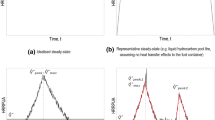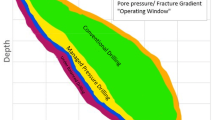Abstract
The oil and gas industry is a theater of major accidents such as fire, explosion and dispersion of toxic substances. The physicochemical properties of exploited materials in this industry and its operating techniques can contribute to the escalation of these hazards. The aim of this study is to assess and model the fire and explosion hazards of liquefaction natural gas in Algeria as long as this later plays an important role in gas industry and global energy markets in the next several years. The first step used in this study is the hazard identification using HAZID tool. This step is completed by DOW’s F&EI as a second step to predict and quantify mathematically the fire and explosion damages in the Scrub Column and the MCHE the most critical systems in the LNG unit. In order to better understand the hazards severity of these risks, PHAST software is used to model and simulate the accident scenarios. The results will reveal that the two principal equipments of liquefaction unit (Scrub Column–MCHE) present an important risk as per HAZID and they present a severe risk as per DOW’s F&EI. The modelization of fire and explosion scenarios using PHAST software gives us a real image about these hazards which presented by Fireball, Flash Fire, Early and Late explosion. The combination of HAZID, DOW’s F&EI and PHAST simulator leads to better risk assessment, and helps in creating preventive measures, and taking serious decisions to reduce and limit fire and explosion risks in order to save human life as a first goal, environment and installations as a second goal and to avoid the financial and economic loss of Algeria.













Similar content being viewed by others
Abbreviations
- ESD:
-
Emergency shut down
- F1:
-
General process hazard factor
- F2:
-
Special process hazard factor
- F3:
-
Process unit hazard factor
- F&EI:
-
Fire and explosion index
- FHA:
-
Fire hazard analysis
- FMEA:
-
Failure modes and effects analysis
- GL1K:
-
Liquefaction natural gas complex—Skikda
- HRA:
-
Human reliability analysis
- HAZID:
-
Hazard identification
- HAZOP:
-
Hazard and operability analysis
- LFL:
-
Low flammable limit
- LMR:
-
Liquid mixed refrigerant
- LNG:
-
Liquefied natural gas
- LPG:
-
Liquefied petrol gas
- MCHE:
-
Main cryogenic heat exchanger
- MF:
-
Material factor
- MR:
-
Mixed refrigerant
- NFPA:
-
National fire protection association
- PHA:
-
Process hazard analysis
- SIL:
-
Safety integrity level
- VCE:
-
Vapor cloud explosion
References
N. Paltrinieri, A. Tugnoli, V. Cozzani, Hazard identification for innovative LNG regasification technologies. J. Reliab. Eng. Syst. Saf. 137, 18–28 (2015)
T.F. Barry, Risk-informed industrial fire protection engineering, in SFPE Handbook of Fire Protection Engineering, 5th Edition, ed. M.J. Hurley, D. Gottuk, J.R. Hall Jr, K. Harada, E. Kuligowski, M. Puchovsky, J. Torero, J.M. Watts Jr, C. Wieczorek, 2016, pp. 3183–3210
P.K. Marhavilas, D. Koulouriotis, V. Gemeni, Risk analysis and assessment methodologies in the work sites: on a review, classification and comparative study of the scientific literature of the period 2000–2009. J. Loss Prev. Process Ind. 24(5), 477–523 (2011)
N. Hyatt, Guidelines for Process Hazards Analysis, Hazards Identification & Risk Analysis, 1st Edition, 2003 by Dyadem Press, pp. 6-1–6-26
V. Kukhar, N. Yelistratova, V. Burko, Y. Nizhelska, O. Aksionova, Estimation of occupational safety risks at energetic sector of iron and steel works. Int. J. Eng. Technol. 7(223), 216–220 (2018)
J. Nakayama, J. Sakamoto, N. Kasai, T. Shibutani, Science direct preliminary hazard identification for qualitative risk assessment on a hybrid gasoline-hydrogen fueling station with an on-site hydrogen production system using organic chemical hydride. Int. J. Hydrog. Energy 41(18), 7518–7525 (2016)
J. Wang, W. Song, Journal of loss prevention in the process industries fire and explosion index calculation method incorporating classified safety measure credits. J. Loss Prev. Process Ind. 26(6), 1128–1133 (2013)
R. Wang, Y. Wu, Y. Wang, X. Feng, An industrial area layout optimization method based on dow’ s fire and explosion index method. Chem. Eng. Trans. 61, 493–498 (2017)
M. Ghasemi, S. Givehchi, Z. Branch, I. Azad, Z. Branch, Modeling the outcome of tank explosion using PHAST software and presentation of emergency operations plan (case study: ethylene tank of kavian petrochemical company). J. Fundam. Appl. Sci. 8, 2007–2021 (2016)
X.U. Ji-xiang, Risk-identification-based hybrid method for estimating the system. J. Shanghai Jiaotong Univ. (Science) 18(1), 70–75 (2013)
M. Rights, I. Lazakis, O. Turan, T. Rosendahl, Risk assessment for the installation and maintenance activities of a low- speed tidal energy converter, in Marine & Offshore Renewable Energy 2012. Royal Institution of Naval Architects, 2012.
AIChE, Dow’s Fire and Explosion Index Hazard Classification Guide, 7th edn. New York, 1994
M.J. Jafari, The credit of fire and explosion index for risk assessment of iso-max unit in oil refinery. Int. J. Occup. Hyg. 4(1), 10–16 (2011)
J.O.B.N.O.J, Operating Manual Volume I, Section 3-1: Document No: PP-AAA-PP1-105, vol. 1, pp. 1–21
J.O.B.N.O.J., Operating Manual Volume I, Section 3-1: Document No: PP-AAA-PP1-106, vol. 1, pp. 1–36
C. Notice, Operating Manual for the Main Cryogenic Heat Exchanger Skikda LNG Project APCI Project EN060585
A. Products, P.D. Number, Vendor Document Cover Sheet for the MCR® Main Cryogenic Heat Exchanger
A. Naemnezhad, A. Akbar, I. Ebrahim, Consequence assessment of separator explosion for an oil production platform in South of Iran with PHAST software. J. Model. Earth Syst. Environ. 3(1), 1–12 (2017)
M.J. Assael, K.E. Kakosimos, Fires, Explosions, and Toxic Gas Dispersions_ Effects Calculation and Risk Analysis, 1st edn, 2010
K. Wang, Z. Liu, X. Qian, M. Li, P. Huang, Comparative study on blast wave propagation of natural gas vapor cloud explosions (VCEs) in open space based on full-scale experiment comparative study on blast wave propagation of natural gas vapor cloud explosions (VCEs) in open space based on full-scale experiment and PHAST. J. Energy Fuels 30(No7), 6143–6152 (2016)
Author information
Authors and Affiliations
Corresponding author
Additional information
Publisher's Note
Springer Nature remains neutral with regard to jurisdictional claims in published maps and institutional affiliations.
Rights and permissions
About this article
Cite this article
Saloua, B., Mounira, R. & Salah, M.M. Fire and Explosion Risks in Petrochemical Plant: Assessment, Modeling and Consequences Analysis. J Fail. Anal. and Preven. 19, 903–916 (2019). https://doi.org/10.1007/s11668-019-00698-8
Received:
Accepted:
Published:
Issue Date:
DOI: https://doi.org/10.1007/s11668-019-00698-8




